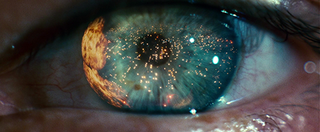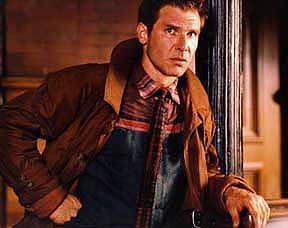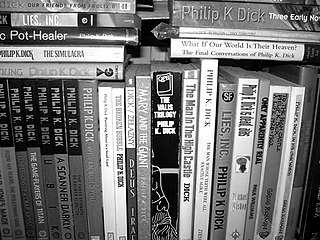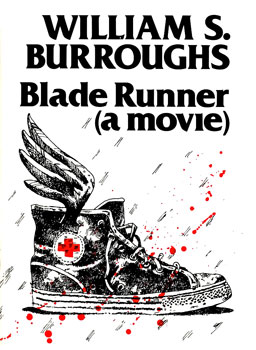
Blade Runner is a 1982 science fiction film directed by Ridley Scott, and written by Hampton Fancher and David Peoples. Starring Harrison Ford, Rutger Hauer, Sean Young, and Edward James Olmos, it is an adaptation of Philip K. Dick's 1968 novel Do Androids Dream of Electric Sheep? The film is set in a dystopian future Los Angeles of 2019, in which synthetic humans known as replicants are bio-engineered by the powerful Tyrell Corporation to work on space colonies. When a fugitive group of advanced replicants led by Roy Batty (Hauer) escapes back to Earth, burnt-out cop Rick Deckard (Ford) reluctantly agrees to hunt them down.

Blade Runner 3: Replicant Night is a science fiction novel by an American writer K. W. Jeter, first published in 1996. It is a continuation of Jeter's novel Blade Runner 2: The Edge of Human, which was itself a sequel to both the film Blade Runner and the novel upon which the film was based, Philip K. Dick's Do Androids Dream of Electric Sheep?

Blade Runner 2: The Edge of Human (1995) is a science fiction novel by American writer K. W. Jeter. It is a continuation of both the film Blade Runner and the novel upon which the film was based, Philip K. Dick's Do Androids Dream of Electric Sheep?

Cyberpunk is a subgenre of science fiction in a dystopian futuristic setting that tends to focus on a "combination of lowlife and high tech", featuring futuristic technological and scientific achievements, such as artificial intelligence and cyberware, juxtaposed with societal collapse, dystopia or decay. Much of cyberpunk is rooted in the New Wave science fiction movement of the 1960s and 1970s, when writers like Philip K. Dick, Michael Moorcock, Roger Zelazny, John Brunner, J. G. Ballard, Philip José Farmer and Harlan Ellison examined the impact of drug culture, technology, and the sexual revolution while avoiding the utopian tendencies of earlier science fiction.

Philip Kindred Dick, often referred to by his initials PKD, was an American science fiction writer. He wrote 44 novels and about 121 short stories, most of which appeared in science fiction magazines during his lifetime. His fiction explored varied philosophical and social questions such as the nature of reality, perception, human nature, and identity, and commonly featured characters struggling against elements such as alternate realities, illusory environments, monopolistic corporations, drug abuse, authoritarian governments, and altered states of consciousness. He is considered one of the most important figures in 20th century science fiction.

Do Androids Dream of Electric Sheep? is a 1968 dystopian science fiction novel by American writer Philip K. Dick. It is set in a post-apocalyptic San Francisco, where Earth's life has been greatly damaged by a nuclear global war, leaving most animal species endangered or extinct. The main plot follows Rick Deckard, a bounty hunter who has to "retire" six escaped Nexus-6 model androids, while a secondary plot follows John Isidore, a man of sub-par IQ who aids the fugitive androids.
A replicant is a fictional bioengineered humanoid featured in the 1982 film Blade Runner and the 2017 sequel Blade Runner 2049 which is physically indistinguishable from an adult human and often possesses superhuman strength and intelligence. A replicant can be detected by means of the fictional Voight-Kampff test in which emotional responses are provoked; a replicant's nonverbal responses differ from those of a human. Failing the test leads to execution, which is euphemistically referred to as "retiring."

Alan Edward Nourse was an American science fiction writer and physician. He wrote both juvenile and adult science fiction, as well as nonfiction works about medicine and science. His SF works sometimes focused on medicine and/or psionics.

Total Recall 2070 is a science fiction television series influenced by the work of Philip K. Dick. It was first broadcast in 1999 on the Canadian television channel CHCH-TV and later the same year on the American Showtime channel. It was later syndicated in the United States with some editing to remove scenes of nudity, violence and strong language.

Despite the initial appearance of an action film, Blade Runner operates on an unusually rich number of dramatic levels. As with much of the cyberpunk genre, it owes a large debt to film noir, containing and exploring such conventions as the femme fatale, a Chandleresque first-person narration in the Theatrical Version, the questionable moral outlook of the hero—extended here to include even the literal humanity of the hero, as well as the usual dark and shadowy cinematography.

Marvel Comics Super Special: Blade Runner or just Blade Runner is a comic book adaptation of the film Blade Runner, published by Marvel Comics in 1982. It was written by Archie Goodwin with art by Al Williamson, Carlos Garzon with Dan Green and Ralph Reese.

Rick Deckard is a fictional character and the protagonist of Philip K. Dick's 1968 novel Do Androids Dream of Electric Sheep?. Harrison Ford portrayed the character in the 1982 film adaptation, Blade Runner, and reprised his role in the 2017 sequel, Blade Runner 2049. James Purefoy voiced the character in the 2014 BBC Radio 4 adaptation.

The bibliography of Philip K. Dick includes 44 novels, 121 short stories, and 14 short story collections published by American science fiction author Philip K. Dick during his lifetime.
Blade Runner is a 1982 science fiction film directed by Ridley Scott.

Blade Runner (a movie) is a science fiction novella by Beat Generation author William S. Burroughs, first published in 1979.
Do Androids Dream of Electric Sheep? is a science fiction novel by American writer Philip K. Dick.
Blade Runner is an American science fiction media franchise originating from the 1968 novel Do Androids Dream of Electric Sheep? by Philip K. Dick, about the character of Rick Deckard. The book has been adapted into several media, including films, comics, a stage play, and a radio serial. The first film adaptation was Blade Runner, directed by Ridley Scott in 1982. Although the film initially underperformed at the American box office, it became a cult classic, and has had a significant influence on science fiction. A novelization and a comic adaptation of the film were released in the same year. From 1995 to 2000, three novels serving as sequels to both Blade Runner and the original novel were written by K. W. Jeter, a friend of Dick's. A film sequel to Blade Runner, Blade Runner 2049, was released in 2017. To celebrate the 30th anniversary of Blade Runner in 2012, a short film was released, and in the lead up to the release of Blade Runner 2049, several more short films detailing events that occurred between 2019 and 2049 were released. The influence of the franchise has helped spawn the cyberpunk genre.
Postmodern Metanarratives: Blade Runner and Literature in the Age of Image is a non-fiction book by Décio Torres Cruz published in 2014 by Palgrave Macmillan.













